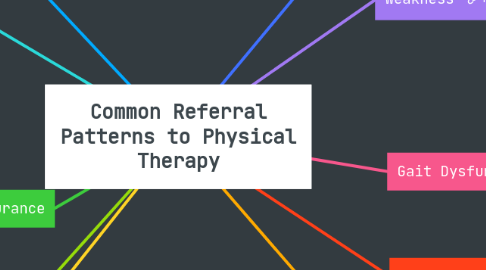
1. Wounds
1.1. Non-Healing Ulcers
2. Open-ended Consults for Diagnostic Assistance
2.1. Differential Diagnosis of Unexplained Symptoms & Signs
2.2. Confusional State of varied etiology
2.2.1. Delirium
2.2.2. Dementia
2.3. Evaluate to assess appropriate medical intervention
2.4. Evaluation for discharge planning
2.4.1. Can this patient be sent home?
2.5. Pre-&-Post Procedural Outcomes
2.5.1. Impact of Baclofen Pump
2.5.2. Impact of Pressure Relief with Lumbar Puncture in decision for CSF shunt
3. Loss of Cardiovascular Endurance
3.1. Cardiac Disease
3.2. Vascular Disease
4. Pulmonary Compromise
4.1. Anesthesia-related Pulmonary complications
4.2. Surgery-related Lung Collapse
4.3. Disease-related pulmonary secretions management
5. Women's Health
5.1. Pelvic floor problems
5.2. Sexual dysfunction
5.3. Peri-Graviderum Issues
6. Pain
6.1. CAUSE
6.1.1. INFLAMMATION
6.1.1.1. SYMPTOMS
6.1.1.1.1. RUBOR
6.1.1.1.2. CALOR
6.1.1.1.3. DOLOR
6.1.1.1.4. TUMOR
6.1.1.1.5. FUNCTIA LEASA
6.1.1.2. MEDIATORS BASED ON ACTIONS (see Table 1 at this link for the expanded Abbreviations of all the Mediators of Inflammation)
6.1.1.2.1. Vasodilation, Increased Vascular Permeability
6.1.1.2.2. Vasoconstriction
6.1.1.2.3. Smooth Muscle Contraction
6.1.1.2.4. Mast cell degranulation
6.1.1.2.5. Stem cell proliferation
6.1.1.2.6. Chemotaxis
6.1.1.2.7. Lysosomal Granule Release
6.1.1.2.8. Phagocytosis
6.1.1.2.9. Platelet aggregation
6.1.1.2.10. Endothelial cell stickiness
6.1.1.2.11. Granuloma Formation
6.1.1.2.12. Pain
6.1.1.2.13. Fever
6.1.2. PSYCHOGENIC
6.2. TYPES
6.2.1. SOMATIC
6.2.1.1. MSK
6.2.1.1.1. TRAUMA
6.2.1.1.2. DEGENERATION
6.2.1.1.3. Disease
6.2.1.2. Neurogenic
6.2.1.2.1. Compression
6.2.1.2.2. Irritation
6.2.1.2.3. Neuropathic
6.2.1.2.4. Regenerative
6.2.1.2.5. Degenerative
6.2.1.3. Visceral
6.2.2. PSYCHOGENIC
6.2.2.1. Malingering
6.2.2.2. True Conversion
7. Weakness
7.1. True Weakness
7.2. Perceived weakness
8. Gait Dysfunction
8.1. Balance impairment
8.2. Fall Risk Assessment
8.3. Syncope
8.4. Others
9. Living Dysfunction
9.1. Developmental - Pediatric failure of milestones
9.2. Failure to Thrive
9.2.1. Adults
9.2.2. Pediatric
9.3. Abuse-related Assessment of Injuries &/or dysfunction
9.3.1. Pediatric Abuse
9.3.2. Elder abuse
9.3.3. Sexual abuse
